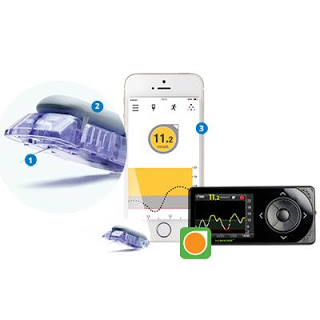The traditional way of monitoring blood sugars is with finger pokes, but there are other newer technologies out there that make it not only easier to check, but provide more data as well.
Two new technologies have recently arrived in Canada: the Freestyle Libre (see
last week’s post on this), which is a poke free glucose monitor, and the Dexcom G5 continuous glucose monitor, which allows you to broadcast sugars wirelessly to family or caregivers.
This week, we’ll review the Dexcom G5.
The Dexcom G5 is a continuous glucose monitor (CGM). This consists of a sensor that you apply to your abdomen (lasts 7 days) which measures glucose in the interstitial fluid that surrounds your cells under your skin, as an estimate of blood glucose levels. There is a transmitter that fits onto the sensor (lasts 3 months), which transmits continuous sugar readings to the reader that comes with it.
It has alarms for low or high sugars.
It needs to be calibrated against finger poke readings every 12 hours, so while the CGM can decrease the number of finger pokes, it doesn’t eliminate them entirely.
While CGMs are not new to Canada, the exciting new feature of this model is that it transmits glucose values not only to the reader, but also to smartphones, iPads, and some smart watches.
Also, the Dexcom5 has been approved in Canada and the USA for making treatment decisions (the previous model, the Dexcom4, is not).
Though there have been reports of inaccuracies, the FDA concluded that ‘the benefits of additional information gained from this device outweigh the inaccurate results, rates of change, and false negative and positive alarms and alerts’. As far as the clinical trials go, the accuracy is reported to be within about 9% of actual blood sugar. The cost is about $3100 per year (ouch!).
This can be a useful tool for parents (it’s approved down to age 2) or caregivers who want to keep an eye on their loved one’s sugars. Also, CGMs with alarms have helped to keep many a patient of mine who have lost their ability to feel low blood sugars safer, waking them up at night when sugars are going low. As for all of the interstitial glucose monitoring technologies – if in doubt about the glucose reading – check with a finger poke.
Follow me on twitter! @drsuepedersen

